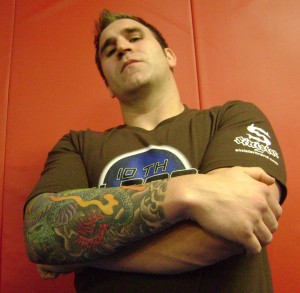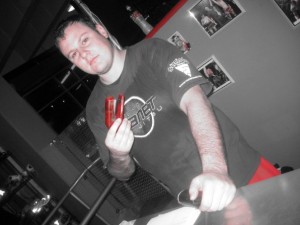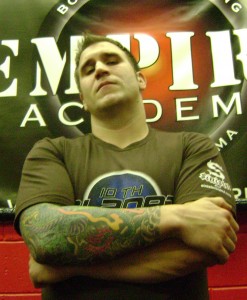Chris Herzog: Skill+Preperation+Right Mind Set = Success. PT.3
March 6th, 2009 In Theory | 2 Comments
Part 3: Right Mind Set
In the final installment of the Equation for Competitive Success, we are going look at a few exercises to help establish the right mind set for competition.
There are several methods and exercises to help develop the Right Mind Set. Finding what works best for you is the key. I’ve found a good blend of concepts from psychology of combat and sports psychology that works best for myself and my students. Three exercises that I like include: Goal setting, positive attitude, and visualization.
Goal Setting: plays a large roll in establishing the right mind set. Goal setting is divided into 3 tiers:
Long term goals: are those that are the hardest to obtain. For many competitors long term goals are the driving force behind their motivation for competitive training. These are largely considered the “dreams” of a competitor. Such aspirations as competing in ADCC, winning Mundials or PanAms, etc would be considered a long-term goal. If these seem extremely difficult to accomplish, they should be, its the reason to wake up every morning and get out of bed and train after you’ve been beaten up the night before. Aim high!
Mid level goals: are very difficult to accomplish, but with hard work and dedication can be achieved. These are the goals that should be the mid waypoint to achieving your long-term goal. You should have to work hard to succeed with mid level goals, but they should be obtainable. If not adjustments may be necessary. Some reasonable mid level goals would be medaling in local and regional level tournaments, qualifiers etc. The main focus should be to take steps towards your long term goal.
Short term goals: should be the meat and potatoes of your goals setting. These are the daily and weekly goals you set for yourself.
They work best for your daily conditioning, flexibility, technical training. Setting short term goals such as number of technical repetitions, beating certain times for conditioning routines, etc. are ideal short term goals. Succeeding in your short term goals builds a foundation for the right mind set.
Write down your goals and share them with your trainers and teammates, its holds you accountable.
Positive Attitude: may sound simplistic, but developing inner strength and appropriate confidence is essential for a successful competitor. Keeping a positive attitude should be centered around things you have control over. Using things like positive statements and keeping a positive attitude when mistakes are made is essential. When mistakes are made, use them as learning tools and an opportunity to make corrections. Keep the positive attitude “I can do that”, or “Next time I’m in that situation, I will succeed”. Developing a positive attitude is hard work, accept the challenge, and work at it daily.
Visualization: is my favorite development tool, its extremely powerful and assists in accomplishing goals and for developing the right mind set.
Visualization is drawing a mental picture or scenario that you play out in your mind. It may be difficult at first but like everything else, the more you practice the better and more vivid it becomes.
The two types of scenarios I stress the most are; the sensation of winning (success) and the execution of your Personal Attacking System against an opponent.
Always try to replicate the competition environment (use all your senses): noisy crowd, matches being called over a loud speaker, guys warming up on the side of the mat, the feel of the mat under your feet, and the sweaty musty smell of your opponent. All of these things brings a familiarity to your visualizations that raises your level of comfort when you compete.
I tend to do my best visualizations, after a hard nights training, as I’m lying in bed before I fall asleep. I run through my Personal Attacking System, imaging a struggle but being successful, then seeing myself getting my hand raised.
Another good opportunity is while your stretching before a practice. This sets the tone for practice and what you’ll be focusing on while you roll/spar.
If your like me, during a training camp I’m fine, up until a week to two weeks out I get random bouts of anxiety about the upcoming event. I could be driving, sitting at my office at work, out to dinner with the wife, etc. One of my coaches used to preach immediately visualizing success at those times. The reason was like Pavlov’s salivating dog theory. You start to equate success with your anxiety and nervousness. This type of random visualization alone has helped myself and my team tremendously. However I don’t support visualization while driving 🙂
Don’t stop with these exercises, these are just the tip of the iceberg. Developing the Right Mind Set is essential for competitor regardless of the sport. All to often we focus on skill training and conditioning and neglect developing our mind for competition as well. Every gym has that one or two guys that tears through everyone in the class, but when they get on the competition mat they get folded like a babies diaper. They only way to get beyond that is to train your mind as part of the greater whole.
By now you should at least have a basic understanding of the planning and process necessary to increases your chances for competitive success. Nothing is for sure, and as most of you know anything can happen during competition. Our attempt is to just increases the odds in our favor and utilizing the Equation for Competitive Success does just that. Good luck and if you have any questions about implementing the Equation for Competitive Successes into your personal program, don’t hesitate to ask.
Â
Chris Herzog is a competitive stud and runs 10th Planet Rochester

Jiu-jitsu Unleashed Book by Eddie Bravo
Click here to order




